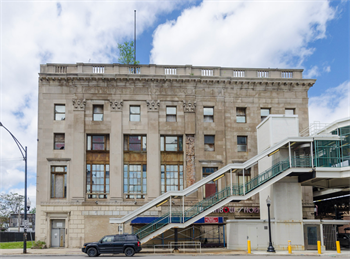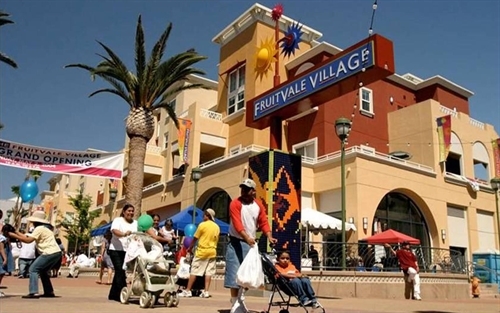
Liz Granger
Community members worked in small groups to create scenarios for redevelopment of the bank building
The intersection of 63rd and Cottage Grove has long been an important gateway to the Woodlawn community. In its heyday, 63rd street was a thriving corridor on the South Side offering a range of retail and entertainment, from jazz clubs to diners to furriers. But by the 1960s, the outlawing of restrictive covenants opened the community to more black families but also sparked white flight and economic disinvestment, resulting in population loss and vacant buildings—properties such as the Washington Park National Bank Building, which stood empty for decades, its basement collecting water.
Enter, the Cook County Land Bank Authority (CCLBA), a group that acquired the Washington Park National Bank Building in 2017. CCLBA is an arm of county government created in 2013 to promote redevelopment of vacant, abandoned, foreclosed or tax-delinquent properties. And CCLBA’s goal with the bank building was simple: clear the property’s back taxes so it can be redeveloped in the highest and best use for the community.
Community engagement as a tool to increase equitable outcomes for neighborhoods
CCLBA did not want to act alone, unilaterally dictating the future of a potential anchor for Woodlawn. So the Land Bank did something notable: it committed to equity and transparency, engaging community stakeholders every step of the way. Woodlawn’s strong network of residents and advocates were ready to build on their community vision advancing ideas for the Washington Park National Bank Building’s redevelopment, from construction ideas to critique. How? CCLBA saw MPC’s Corridor Development Initiative (CDI) process as a natural fit for this catalytic project and invited our team to apply this model of participatory planning to bank building site.
In February, the Metropolitan Planning Council completed a series of community workshops in partnership with the Cook County Land Bank Authority to inform the future development of the former Washington Park National Bank Building at 6300 S. Cottage Grove. MPC’s Corridor Development Initiative (CDI) is a tangible way we move equitable development from concept to practice. Through this process MPC partners with public landowners to gather feedback from community stakeholders before the property is open to bidding from developers. That insight is then used to help shape the future of the site using community input as guiding principles for development.
Building an equity framework
Chicago is split by race and place, heavily shaped by a system of segregation which supports inequity and renders people of color most vulnerable to displacement. But transit-oriented development (TOD) can be a powerful tool for reducing disparity when it is applied using an equity framework.
Equitable transit-oriented development (eTOD) prioritizes the land around transit as model locations for holistic community development partnering with locals leaders to shape projects that are responsive to the social, cultural, economic and environmental needs of the neighborhood. In an ideal situation, you capture all the benefits of TOD (connectivity, reduced congestion, mix of uses), provide inclusive housing or commercial space accessible at various income levels and attract amenities and services that support economic growth and social stability. A main component of our work at MPC is demonstrating the value of equitable development through advocacy, research and application.
Starting the development process with meaningful community engagement is valuable for a number of reasons. Community engagement is an effective way to gain insight on priorities and concerns about development from a local context. It increases understanding of a public process that is complicated and difficult to navigate. It also can improve relationships between the community and public agencies through transparency and the integration of local voices in shaping the final product.

Eric Allix Rogers
The former Washington Park National Bank Building at 63rd and Cottage Grove
At the Woodlawn CDI sessions neighborhood residents, business owners and institutional partners participated in small group discussions, building block exercises and key pad polling to craft specific recommendations that considered market realities economic impacts and how the building design could help improve the health of residents and existing transit assets. Through the three public meetings, an online survey, text polling and a workshop at the Woodlawn Summit, hundreds of participants shared their ideas, concerns and opinions about what is needed at this key intersection.
Supported by volunteer experts in architecture, real estate development and finance, community stakeholders crafted 20 development scenarios for the bank building that illustrate local priorities for how the space could be used and potential design elements. The Cook County Land Bank Authority will use the recommendations detailed in the Woodlawn CDI report to inform a request for proposals (RFP) expected to be issued this year to solicit bids from parties interested in redeveloping the site.
Transformative Impact of eTOD
MPC improves public participation in community development and drives equitable systems change. As a member of Elevated Chicago, we are part of a national coalition of cities working to advance equitable development starting with the areas around transit. Chicago is one of six cities funded by SPARCC, a three-year, $90 million initiative to amplify locally driven efforts to ensure that major new infrastructure investments lead to equitable, healthy opportunities for everyone.
When development is centered in collaborative planning, maximizing connectivity, prioritizing local needs, and creating ways to improve health, environmental impacts and social resilience, then it can be truly be transformative.

Studio T-Square, Oakland, CA
Oakland's Fruitvale Station is a mixed-use transit-oriented development that combines housing and retail with community services and cultural programming.
Fruitvale Village is an example of how community driven development capitalizing on transit access has made a notable difference in a changing neighborhood. Located in Oakland, California, the site was originally intended to be a parking garage for the nearby train station but intervention by community stakeholders changed the direction of the development. Opened in 2004, the former vacant lot is now a mixed-use transit village that includes housing, a charter school, senior center, health clinic and various restaurants, retail and a public market with design and programming that preserves the cultural roots of this historically Latino neighborhood. The Unity Council, a nonprofit social equity development corporation leads the development of Fruitvale Village and is currently working on Phase II which will include an additional 275 affordable housing units in the community.
In a recent study evaluating the impact of the transit village conducted by UCLA Latino Policy & Politics Initiative, researchers found Fruitvale Village has been a stabilizing force against displacement in the surrounding neighborhood. Fourteen years later, Fruitvale residents have better socio-economic outcomes when compared to their peers. The study shows an increase in residents earning a college degree, increase in homeownership and higher incomes. During this time, Fruitvale lost less than 5 percent of its residents of color, which suggests that these positive changes were not driven by displacement of Black and Latino residents. The success of Fruitvale Village and its residents is undoubtedly associated to the thoughtful planning of health, education and social and supportive services built into the community along with easy transit access connecting people to opportunities outside of the neighborhood.
Oakland and Chicago are very different places but Fruitvale Village offers tangible lessons for transit-oriented projects. Design and build an infrastructure that strengthens local commerce, supports culture and social cohesion and provides services that local residents want and need to thrive. Then TOD will not only be a connector of people, places and opportunities but it can become a vehicle for lasting change.
In Woodlawn, that’s the hope. The deliberate and thoughtful engagement of community residents in the redevelopment of the bank building and the entire intersection offers an opportunity for the neighborhood to shape the path to a full-scale revival of a vibrant commercial corridor. And to get it right, the Cook County Land Bank Authority and MPC are tapping Woodlawn’s most important resource: its residents. They are, after all, the experts.